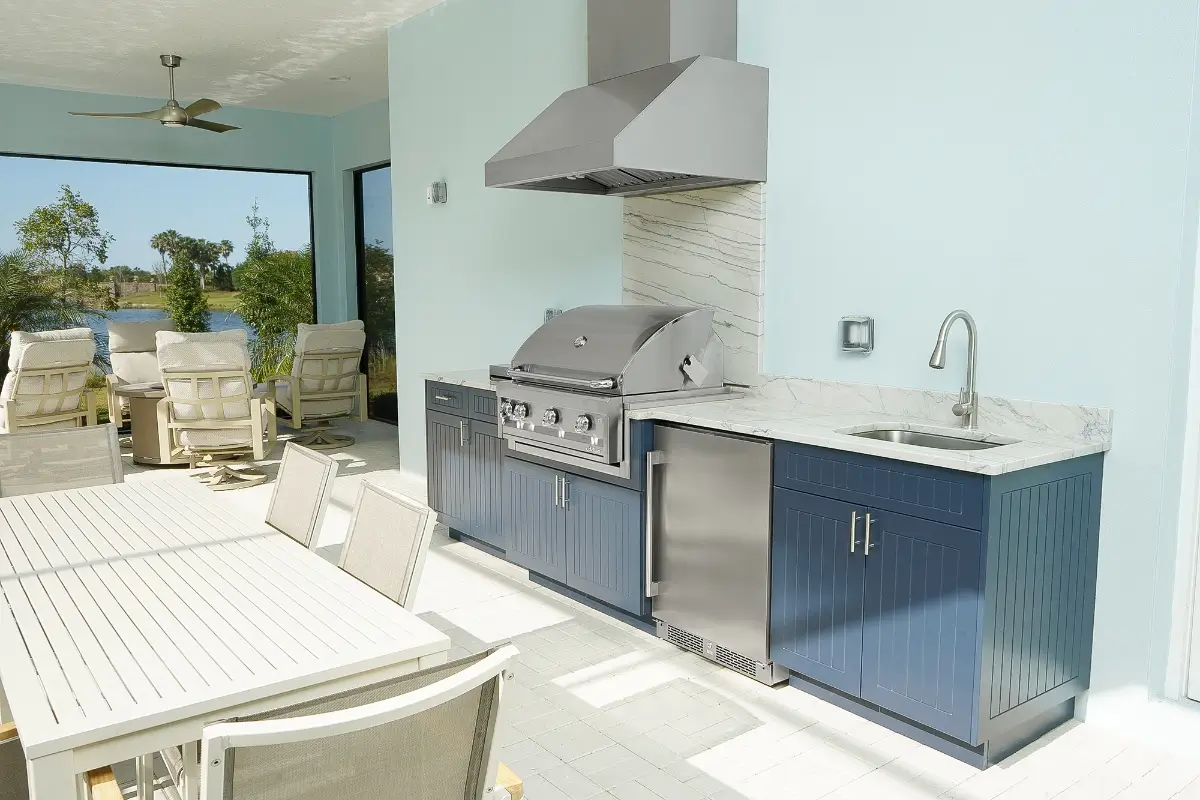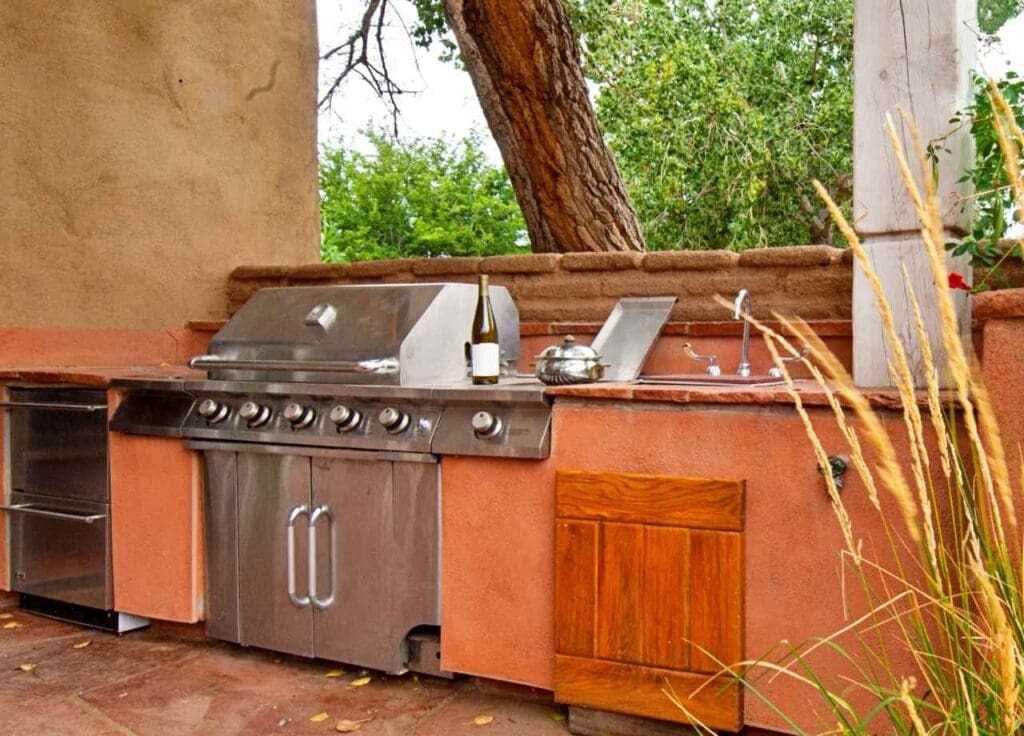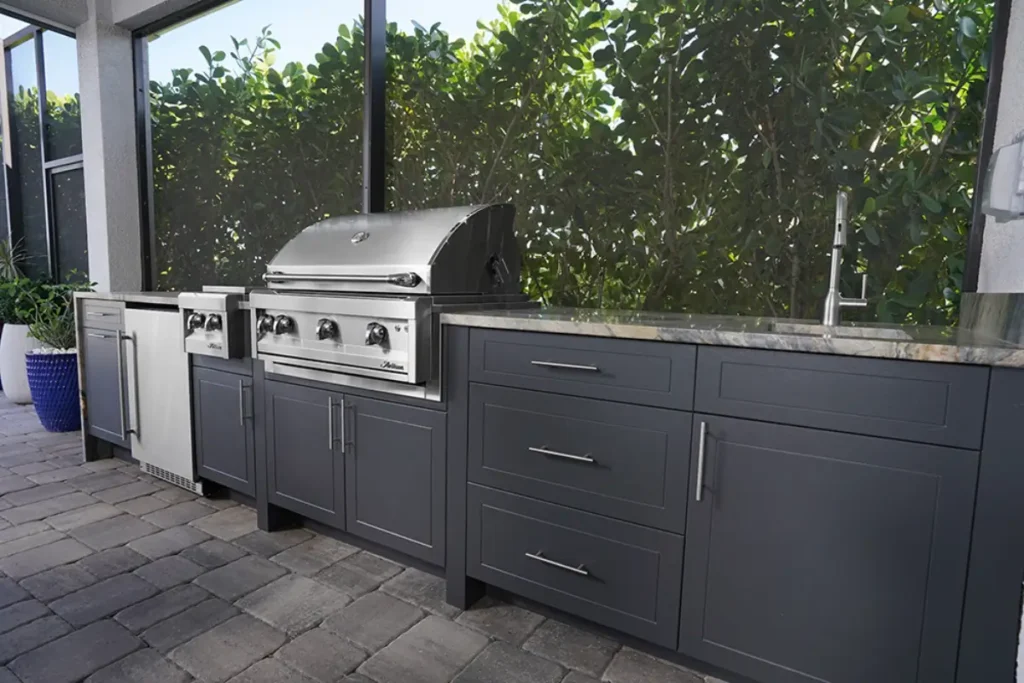
Laminate Cabinets vs. Wood Cabinets: What Works Best for Outdoor Kitchens?
Choosing the right cabinets is a big step in building or upgrading an outdoor kitchen. Materials matter—not just for looks, but for long-term durability and ease of maintenance in your climate. If you’re in Jacksonville or a similar coastal region, the choice between laminate and wood cabinets goes well beyond personal taste. It’s a question of weather resistance, performance, and how much time you’re willing to spend maintaining your space.
At Calico Outdoor, we build custom outdoor kitchens using weather-resistant materials tailored for Northeast Florida’s humidity, salt air, and intense sun. But let’s set that aside for now and dig into what you really came here for: a no-nonsense comparison of laminate and wood cabinets for outdoor use.
Table of Contents
What Are Laminate Cabinets?
Laminate cabinets are made by bonding a thin layer of printed or solid-color material (usually plastic-based) to a substrate like MDF, plywood, or particleboard. High-pressure laminate (HPL) is the more durable version, while low-pressure laminate (LPL) is less expensive and not meant for outdoor use. HPL is usually what’s used in exterior-rated applications.
The outer layer gives the cabinet its color and pattern—wood grain textures, solid shades, or modern finishes like matte or gloss. Underneath, the core determines strength and moisture resistance. Some laminates are applied to marine-grade plywood or composite core materials that can handle wet environments.
Because the surface is manufactured, it’s available in hundreds of finish options. Laminate cabinets can be designed to mimic real wood or go in a totally different direction with modern colors and textures.
What Are Wood Cabinets?
Wood cabinets are exactly what they sound like—made from real hardwood or softwood. In indoor kitchens, species like maple, cherry, and oak are common. For outdoor kitchens, builders often opt for teak, cypress, ipe, or cedar. These woods are chosen for their natural resistance to insects, rot, and moisture damage.
Outdoor-grade wood cabinets are typically built from solid planks or thick veneers over marine-grade cores. A protective finish—usually some form of oil, stain, or UV-resistant sealant—is essential to preserve the wood over time. Even the toughest wood species will weather if not properly maintained.

The appeal of wood comes from its natural grain, warmth, and timeless character. It’s hard to replicate that organic look, even with high-end laminates. But the beauty of real wood comes with strings attached.
Durability in Outdoor Conditions
Outdoor kitchens in humid or coastal areas are exposed to far more than occasional rain. We’re talking direct UV exposure, salty air, mold spores, and temperature swings—all of which can wreak havoc on unprotected materials.
Laminate cabinets with a high-pressure, exterior-grade finish and waterproof substrate can hold up surprisingly well in the elements. They don’t warp, crack, or split. And the surface is non-porous, which helps prevent mildew and stains from settling in. Still, the edges and seams need to be sealed properly. If water gets behind the laminate, it can cause the substrate to swell or break down over time.
Wood cabinets can last just as long—but they need regular upkeep to do so. UV rays bleach unsealed wood, rain can cause swelling or splitting, and Florida’s humidity speeds up decay. Exotic hardwoods like teak or ipe hold up better, but even they require occasional oiling and sealing. Neglect the finish, and you’ll be sanding, re-staining, or replacing sooner than expected.
In terms of raw resilience, high-grade laminate over marine-core materials wins for low-maintenance outdoor performance. But real wood can still hold its own with committed upkeep.
Appearance and Style Options
This is where preferences really start to split. Laminate cabinets are factory-made, so they offer consistent finishes, smooth surfaces, and plenty of color choices. You can go ultra-modern with flat matte tones, mimic painted wood, or choose faux grain patterns that look close to the real thing.
Wood cabinets, by contrast, have unmatched depth and authenticity. The grain variation, natural imperfections, and way wood ages in the sun are what many homeowners love most. It feels lived-in, warm, and timeless.
The downside? Limited control over exact appearance. Stains and sealers behave differently on each board, and natural wood changes color over time. Some folks see that as charm. Others see it as unpredictable.
Laminate gives you design control and consistency, especially across large kitchen runs or matching storage doors. Wood gives you beauty that evolves—but also requires more thought and care during design and long-term use.
Maintenance and Cleaning
Here’s where things get practical. Laminate cabinets are low-maintenance. A quick wipe-down with a damp cloth usually does the trick. No special products, no sealing schedule, no surprises. If they’re made for exterior use, they’ll resist fading, peeling, and surface damage under normal conditions.
Wood, on the other hand, demands attention. You’ll need to clean with appropriate solutions to avoid stripping the finish, then re-oil or reseal as needed—usually once or twice a year in Florida. Let it slide, and weathering sets in fast. Once moisture gets in, rot can follow, especially around joints or hardware.
If you’re the kind of person who enjoys caring for natural materials, wood can be worth the effort. But if you want your outdoor kitchen to stay sharp with minimal upkeep, laminate is the smarter play.
Cost and Long-Term Value
Initial costs vary based on quality, but generally, wood cabinets built for outdoor use will cost more up front—especially if you’re using hardwoods like teak, mahogany, or ipe. Add in the labor for sealing and maintenance products over time, and the total investment keeps growing.
Laminate cabinets can be more cost-effective, particularly when paired with durable, weather-rated substrates. They’re faster to fabricate and install, and you won’t spend on refinishing or protective treatments. That said, low-end laminate should be avoided outdoors. It won’t hold up, and replacing water-damaged cabinets costs more in the long run than choosing the right material from the start.

Over a 10-year lifespan, high-quality laminate cabinets can offer better ROI for homeowners who want a dependable setup without a lot of fuss. Wood may still offer greater resale appeal for buyers who value craftsmanship and the natural look—but that appeal fades quickly if the cabinets show signs of neglect.
Installation Considerations
Outdoor kitchen installations require more than just mounting cabinets to a wall. You’ve got to factor in exposure, water drainage, and how much sun and wind the space will get. Cabinets under a fully covered patio might last longer no matter the material, while units exposed to full weather need better resistance from the ground up.
Laminate cabinets must be properly sealed at seams and corners. Hardware should be corrosion-resistant—preferably stainless steel or marine-grade aluminum. Ventilation is also key to avoid moisture buildup inside the boxes.
Wood cabinets need the same hardware protections but also require solid anchoring to prevent shifting from expansion or contraction. Builders need to leave room for the material to breathe, which makes installation more involved.
Any cabinet installation outdoors benefits from experience. A contractor or builder familiar with Jacksonville’s climate will know how to prepare the area, choose the right materials, and install with long-term performance in mind.
Which Is the Better Choice?
There’s no one-size-fits-all answer here. If you’re drawn to the warmth and character of real wood and don’t mind taking care of it, wood cabinets can add undeniable charm to your outdoor space. Just know they’ll need regular attention and won’t always look the same from year to year.
If you prefer something that holds its appearance longer and requires far less maintenance, exterior-rated laminate cabinets make more sense. Especially in Florida’s climate, the durability and ease of use often outweigh the slightly less “natural” appearance.
At the end of the day, the best choice depends on how you use your outdoor kitchen, how much exposure it gets, and how much effort you’re willing to put into upkeep. For homeowners who want something built to last without the yearly maintenance schedule, Calico Outdoor leans toward high-performance laminate with marine-grade cores. But we’ll always design to fit your vision—whether that means wood’s timeless feel or laminate’s modern edge.
